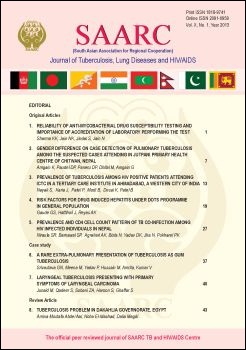Prevalence and CD4 Cell Count Pattern of TB Co-infection Among HIV Infected Individuals In Nepal
DOI:
https://doi.org/10.3126/saarctb.v10i1.8674Keywords:
HIV, TB co-infection, CD4 cell count, Clinical features, ARTAbstract
Background: Mycobacterium tuberculosis (TB) and Human Immunodefi ciency Virus (HIV) infections are two major public health problems in many parts of the world, particularly in developing counties like Nepal. The objective of the study is to find out prevalence and clinical presentation of the TB co-infection among HIV infected individuals and pattern of CD4 cell count in relation to types of TB and response of ART.
Methodology: This is a cross-sectional study carried out in three VCT clinics from Dharan and Kathmandu from April 2010 to March 2011. The appropriate samples, 313 HIV individuals were taken as study sample.
Results: The study revealed that more than 36% of individuals were co-infected with TB. Among them, nearly 65% had pulmonary TB, more than one-forth had gland TB. There is signifi cant association of TB co-infection among male compared to females (P=0.021). Fever, weight loss and cough were found to have signifi cant symptoms associated with TB-HIV co-infection. The average CD4 count among TB co-infected population was signifi cantly less compared to uninfected ones just before starting ART (P=0.022) and even after six months (P=0.001). After one year of ART continuation, there was no signifi cant association on average CD4 count among the two groups. But then, the mean CD4 count became more in TB co-infected individuals compared to those who had no TB co-infection.
Conclusion: TB-HIV co-infection is an emerging medical issue in Nepal. More than one third of HIV patients are co-infected with TB. Consideration of TB need to be made while caring patients with HIV infection and vice versa. ART plays very important role in increasing CD4 cell count among TB-HIV coinfected patients.
SAARC Journal of Tuberculosis, Lung Diseases & HIV/AIDS; 2013; X(1); 27-36
DOI: http://dx.doi.org/10.3126/saarctb.v10i1.8674Downloads
Downloads
Published
How to Cite
Issue
Section
License
Copyright © SAARC Tuberculosis and HIV/AIDS Centre (STAC), all rights reserved, no part of this publication may be reproduced, stored in a retrieval system or transmitted in any form or by any means without prior permission of the STAC.





